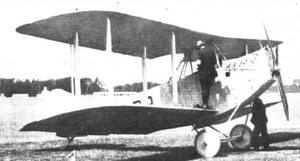LFG V 39
| V 39 | |
|---|---|
 | |
| Role | Training aircraft |
| National origin | Germany |
| Manufacturer | LFG (Luft-Fahrzeug-Gesellschaft) |
| First flight | 1925 or earlier |
|
| |
The LFG V 39 was a simple biplane trainer built in Germany in the mid-1920s. It took part in the Round Germany Flight in the summer of 1925.
Design and development
The V 39 was a two bay biplane with constant chord wings mounted with slight stagger and a wide gap. The fabric covered wings had box spars and three-ply ribs.[1] There were ailerons on both upper and lower wing, externally rod-connected. The upper wing was centrally supported with cabane struts.[2]
The trainer was designed to be powered by a 75 kW (100 hp) Mercedes D.I or 89 kW (120 hp) D.II engine.[1] It is known that the smaller engine at least was flown.[2] The fuselage was deep bellied, flat sided, constructed from wood and covered with three-ply.[1] There were two open, tandem cockpits, the rear one provided with vision enhancing trailing edge cut-outs in both upper and lower planes. The V 39's undercarriage was standard for the time, with mainwheels on a rigid axle supported by fuselage mounted V-struts and with a tailskid.[2]
The V 39 was designed to combine modest performance with reliability and robustness with easy handling and a low landing speed.[1]
Operational history
The V 39 was one of more than ninety aircraft to take part in the Round Germany Flight held in the summer of 1925.[1]
Specifications
Data from Flight 28 May 1925 p.323[1]
General characteristics
- Length: 7.85 m (25 ft 9 in)
- Wingspan: 12 m (39 ft 4 in)
- Wing area: 40 m2 (430 sq ft)
- Empty weight: 803 kg (1,770 lb)
- Gross weight: 1,130 kg (2,491 lb)
- Powerplant: 1 × Mercedes D.I 6-cylinder water cooled upright inline, 75 kW (100 hp)
- Propellers: 2-bladed [2]
Performance
- Maximum speed: 125 km/h (78 mph; 67 kn)
- Service ceiling: 3,800 m (12,467 ft)
- Time to altitude: 8 min to 1,000 m (3,280 ft)
- Landing speed: 55 km/h (34 mph)
References
| Wikimedia Commons has media related to LFG Roland. |
| ||||||||||||||
| ||||||||||||||||||||||